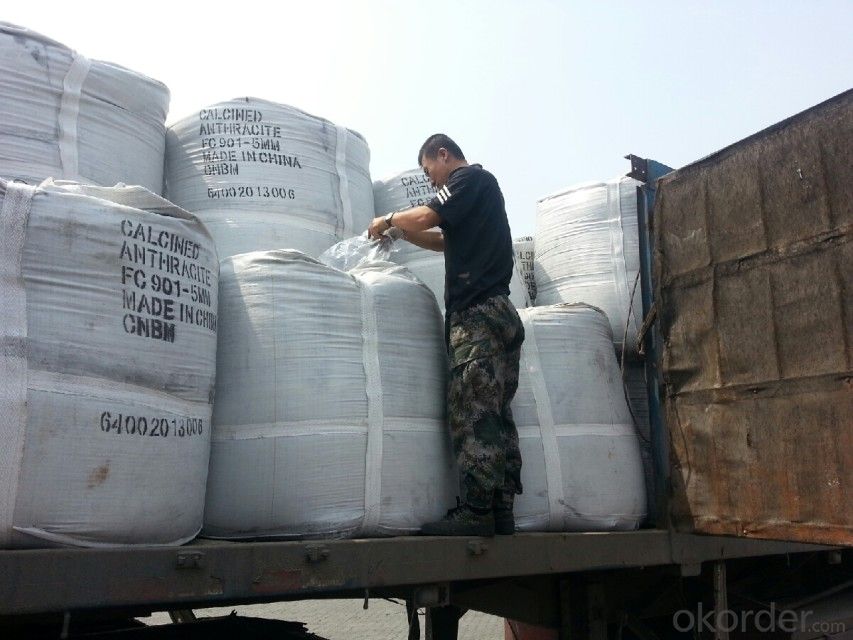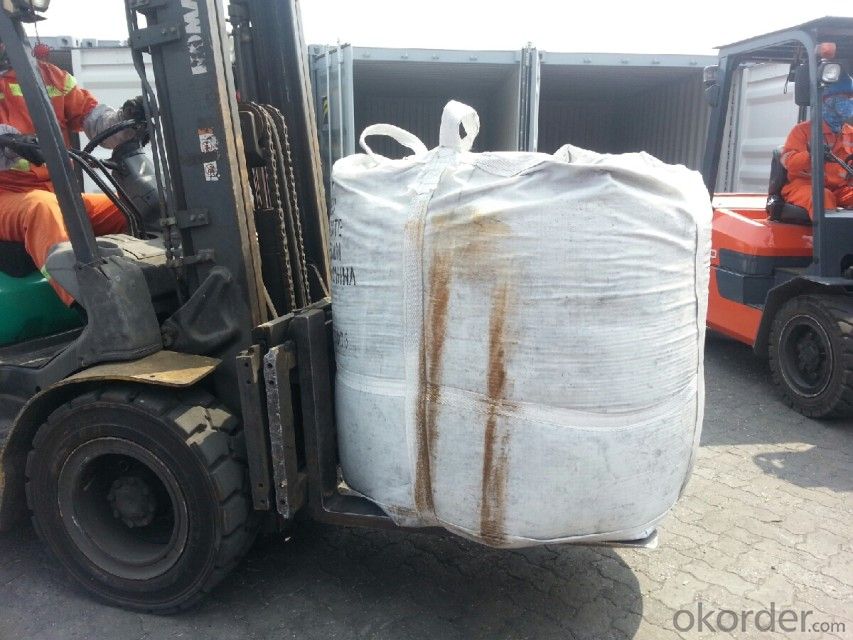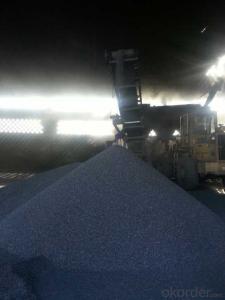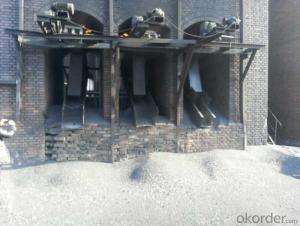FC 82% Calcined Anthracite Coal Used as Injection Carbon
- Loading Port:
- Tianjin
- Payment Terms:
- TT OR LC
- Min Order Qty:
- 20 m.t.
- Supply Capability:
- 5000 m.t./month
OKorder Service Pledge
OKorder Financial Service
You Might Also Like
Packaging & Delivery
FC 82% Calcined Anthracite Coal Used as Injection Carbon
25kgs/50kgs/1ton per bag or as buyer's request
Specifications
FC 82% Calcined Anthracite Coal Used as Injection Carbon
Calcined Anthracite
Fixed carbon: 90%-95%
S: 0.5% max
Size: 0-3. 3-5.3-15 or as request
FC 82% Calcined Anthracite Coal Used as Injection Carbon
It used the high quality anthracite as raw materials through high temperature calcined at over 2000 by the DC electric calciner with results in eliminating the moisture and volatile matter from anthracite efficiently, improving the density and the electric conductivity and strengthening the mechanical strength and anti-oxidation. It has good characteristics with low ash, low resistvity, low sulphur, high carbon and high density. It is the best material for high quality carbon products.
Advantage and competitive of caclined anthracite:
FC 82% Calcined Anthracite Coal Used as Injection Carbon
1. strong supply capability
2. fast transportation
3. lower and reasonable price for your reference
4.low sulphur, low ash
5.fixed carbon:95% -90%
6..sulphur:lower than 0.3%
General Specification of Calcined Anthracite:
FC 82% Calcined Anthracite Coal Used as Injection Carbon
| FC | 90 | 88 | 85 | 83 | 82 |
| ASH | 8.5 | 10 | 12 | 14 | 15 |
| V.M. | 1.5 | 2 | 3 | 3 | 3 |
| S | 0.35 | 0.5 | 0.5 | 0.5 | 0.5 |
| MOISTURE | 0.5 | 1 | 1 | 1 | 1 |
Pictures
FC 82% Calcined Anthracite Coal Used as Injection Carbon




FC 82% Calcined Anthracite Coal Used as Injection Carbon
1.High quality and competitive price.
2.Timely delivery.
3.If any item you like. Please contact us.
Your sincere inquiries are typically answered within 24 hours.
2.Timely delivery.
3.If any item you like. Please contact us.
Your sincere inquiries are typically answered within 24 hours.
- Q:I saw a cell phone in the magazine, the global release of 900, no camera, what function is F1 carbon fiber material, actually sold 40000 yuan a piece!.. Everyone said that the circulation is so small, worth so much money? Or carbon fiber material worth so much money?
- In fact, whether carbon fiber or 900 are gimmicks, he is in the advertising of this mobile phone to deceive people
- Q:What are the limitations of carbon dating?
- Carbon dating, also known as radiocarbon dating, is a widely used method for determining the age of organic materials up to 50,000 years old. While it has revolutionized the field of archaeology and paleontology, it does have certain limitations that researchers must be aware of. One limitation of carbon dating is its inability to accurately date materials beyond the 50,000-year mark. This is due to the fact that carbon-14, the isotope used in carbon dating, has a half-life of only 5,730 years. As a result, after several half-lives, there is not enough carbon-14 remaining in a sample to accurately determine its age. Another limitation is the reliance on organic material. Carbon dating can only be used on organic materials such as bones, shells, wood, and charcoal. This means that it is not applicable to inorganic materials like rocks or minerals. Additionally, the presence of certain contaminants in the sample, such as humic acids or carbonates, can distort the carbon dating results. Furthermore, carbon dating is limited by the fact that it can only provide a relative age for the sample. It determines the ratio of carbon-14 to carbon-12 in the sample and compares it to the known ratio in the atmosphere. By assuming that the ratio has remained constant over time, an estimate of the sample's age can be made. However, variations in the atmospheric carbon-14 levels over time can affect the accuracy of this method. Additionally, carbon dating can be influenced by the presence of nuclear testing and other human activities that have released significant amounts of carbon-14 into the atmosphere. This is known as the "bomb effect" and can result in artificially younger dates for samples collected after the mid-20th century. Lastly, carbon dating can be limited by the size and condition of the sample. In order to obtain accurate results, a sufficient amount of organic material is required for analysis. This can be challenging when dealing with small or degraded samples, as the carbon-14 content may be insufficient or contaminated. In conclusion, while carbon dating is a valuable tool for determining the age of organic materials, it does have certain limitations. Researchers must consider these limitations and be cautious when interpreting the results, taking into account the age range, sample type, presence of contaminants, atmospheric variations, and sample size.
- Q:What are the different types of carbon-based concrete additives?
- There are several different types of carbon-based concrete additives that can enhance the performance and properties of concrete. These additives are primarily derived from carbon-based materials and can be categorized into three main types: carbon nanotubes, graphene, and carbon fibers. 1. Carbon Nanotubes: These are cylindrical structures made up of carbon atoms arranged in a unique hexagonal pattern. Carbon nanotubes have exceptional mechanical and electrical properties, making them highly desirable as concrete additives. When added to concrete, they can improve its strength, durability, and toughness. Carbon nanotubes also enhance the electrical conductivity of concrete, which is beneficial for applications such as self-healing concrete and anti-static flooring. 2. Graphene: Graphene is a single layer of carbon atoms arranged in a two-dimensional lattice. It is known for its exceptional strength, high electrical conductivity, and excellent barrier properties. When incorporated into concrete, graphene can significantly improve its mechanical properties, such as compressive strength, flexural strength, and abrasion resistance. It also enhances the durability and impermeability of concrete, providing resistance against water and chemical ingress. 3. Carbon Fibers: These are long, thin strands of carbon, typically derived from organic polymers such as polyacrylonitrile or pitch. Carbon fibers possess excellent tensile strength and are widely used as reinforcements in various construction materials, including concrete. When added to concrete, carbon fibers can enhance its flexural strength, impact resistance, and cracking behavior. They also improve the ductility and toughness of concrete, making it more resistant to dynamic loads. It is worth noting that each type of carbon-based concrete additive has its unique advantages and applications. Carbon nanotubes offer exceptional mechanical and electrical properties, graphene provides enhanced strength and barrier properties, while carbon fibers enhance flexural strength and impact resistance. The choice of additive depends on the specific requirements of the concrete application and the desired performance characteristics.
- Q:How is carbon used in the production of textiles?
- Carbon is used in the production of textiles in several ways. One of the most common uses of carbon in textiles is in the form of carbon fibers. These fibers are lightweight, strong, and have high tensile strength. They are used to reinforce various types of fabrics, adding durability and enhancing their performance. Carbon is also used in the production of activated carbon, which is a highly porous material. Activated carbon is commonly used in textile production for its ability to adsorb and remove unwanted odors and chemicals. It is used in the manufacturing of fabrics for sportswear, workwear, and other specialized textiles where odor control is important. Furthermore, carbon black, a fine powder made of carbon particles, is used as a pigment in textile printing and dyeing. It provides deep black color to fabrics and is commonly used in the production of garments, upholstery, and other textiles where a dark color is desired. Another innovative use of carbon in textiles is through the development of carbon nanotextiles. These textiles are made from carbon nanotubes, which are cylindrical structures composed of carbon atoms. Carbon nanotextiles have unique properties such as high electrical conductivity and thermal stability, making them ideal for applications like wearable electronics, smart textiles, and conductive fabrics. In summary, carbon is widely used in the production of textiles through the incorporation of carbon fibers, activated carbon, carbon black, and carbon nanotubes. These applications contribute to the strength, durability, odor control, coloration, and functionality of various types of textiles.
- Q:Power plant water treatment plant, there is a carbon removal device, the expert pointing out what the principle is it?
- The solubility of carbon dioxide gas in water obeys Henry's law, i.e., the solubility of gases in solution is proportional to the partial pressure of the gas on the liquid surface at a given temperature. So only to reduce carbon dioxide gas in contact with the water in the partial pressure of carbon dioxide dissolved in water and free from water will be desorbed, which will remove carbon dioxide free water, carbon remover is the principle of design!
- Q:How does carbon dioxide contribute to global warming?
- Carbon dioxide contributes to global warming primarily through the greenhouse effect. When released into the atmosphere from various human activities such as burning fossil fuels and deforestation, carbon dioxide acts as a greenhouse gas. It traps heat within the Earth's atmosphere, preventing it from escaping back into space. This results in the overall increase in temperature on the planet, leading to global warming and its associated consequences such as rising sea levels, extreme weather events, and the disruption of ecosystems.
- Q:How does carbon impact the availability of clean transportation?
- The contribution of carbon to greenhouse gas emissions affects the availability of clean transportation. Carbon dioxide (CO2) is a significant greenhouse gas that is responsible for climate change. When fossil fuels are burned in traditional transportation systems, they release large amounts of CO2 into the atmosphere. As a result, there is an urgent need for cleaner alternatives in the transportation sector. Clean transportation options, such as electric vehicles (EVs) and hydrogen fuel cell vehicles, have been designed to minimize carbon emissions. These vehicles use electricity or hydrogen as their primary source of energy, resulting in zero tailpipe emissions. This greatly reduces the carbon footprint associated with transportation. However, the availability and adoption of these clean transportation solutions are directly influenced by carbon-related factors. One important factor is the energy infrastructure required to support clean transportation. Electric vehicles, for instance, depend on charging stations and a reliable power grid. It is crucial to produce clean electricity from renewable sources like solar and wind to ensure that EVs are truly emission-free. Therefore, the carbon intensity of the electricity grid plays a crucial role in determining the environmental impact of electric transportation. Moreover, the availability of carbon-neutral fuels is another significant aspect. Hydrogen fuel cell vehicles, which use hydrogen to generate electricity, require a readily available and sustainable source of hydrogen. Currently, most hydrogen is produced from natural gas, which emits CO2 during the production process. However, advancements in technologies like electrolysis, which uses renewable electricity to produce hydrogen, are making way for carbon-free hydrogen production. Additionally, carbon pricing and policies also influence the availability of clean transportation. Governments and organizations incentivize the adoption of low-carbon transportation options by placing a price on carbon emissions. This can lead to increased investments in clean transportation infrastructure, research, and development, ultimately making clean transportation solutions more available and affordable. In conclusion, the emissions of carbon from traditional transportation systems have necessitated the development and availability of clean transportation alternatives. Factors such as energy infrastructure, availability of carbon-neutral fuels, and supportive policies all impact the availability and accessibility of clean transportation. By addressing carbon impacts, we can expedite the transition to a more sustainable and environmentally-friendly transportation system.
- Q:What are the impacts of carbon emissions on human respiratory diseases?
- Carbon emissions have significant impacts on human respiratory diseases. The release of carbon dioxide and other greenhouse gases from various sources, such as burning fossil fuels and deforestation, contributes to air pollution. This pollution can lead to the exacerbation of respiratory conditions such as asthma, chronic obstructive pulmonary disease (COPD), and respiratory infections. Additionally, exposure to particulate matter and toxic chemicals emitted from carbon-based industries can increase the risk of developing respiratory diseases and worsen existing conditions. Overall, reducing carbon emissions is crucial to mitigate the adverse effects on human respiratory health.
- Q:What is the density of carbon?
- Carbon's density varies depending on its form. Graphite, the most prevalent form of carbon, has a density of 2.267 g/cm³. In contrast, diamond, another form of carbon, boasts a significantly higher density of 3.515 g/cm³. Therefore, it is crucial to specify the form of carbon being discussed when referring to its density.
- Q:How does carbon impact the stability of savannah ecosystems?
- The stability of savannah ecosystems relies heavily on carbon, which is crucial for all living organisms and involved in various ecological processes. Carbon exists primarily in the form of organic matter, which is vital for the growth and development of plants, the primary producers in these ecosystems. In savannahs, carbon affects stability in multiple ways. Firstly, carbon dioxide (CO2) plays a significant role in regulating the global climate as a key component of the Earth's atmosphere. Savannahs have the ability to sequester and store large amounts of carbon in their vegetation and soils, thereby mitigating climate change by reducing CO2 levels in the atmosphere. Carbon is also essential for plant growth through photosynthesis. Savannah plants, like grasses and scattered trees, utilize carbon dioxide from the air to produce carbohydrates and other organic compounds. This process not only provides plants with energy but also contributes to the overall productivity of the ecosystem. The stability of savannah ecosystems is also dependent on the interaction between plants and animals. Carbon-rich vegetation serves as a food source for herbivores, which in turn support predators. The carbon cycle ensures a continuous flow of energy and nutrients throughout the food web, maintaining ecosystem balance and stability. Moreover, the carbon content in savannah soils affects their fertility and ability to retain moisture. Organic matter derived from decaying plant material improves soil structure, nutrient availability, and water holding capacity. This, in turn, supports vegetation growth and sustains the diverse array of species found in savannah ecosystems. However, human activities such as deforestation, agricultural practices, and the burning of fossil fuels are disrupting the carbon balance in savannahs. Deforestation removes carbon-rich trees and plants, reducing the overall carbon storage capacity of the ecosystem. Additionally, the release of carbon dioxide from burning fossil fuels contributes to the greenhouse effect and climate change, which can disrupt savannah ecosystem stability. In conclusion, carbon plays a critical role in maintaining the stability of savannah ecosystems. It influences climate regulation, supports plant growth, provides energy for the food web, and enhances soil fertility. However, human activities that disrupt the carbon balance in these ecosystems can have detrimental effects on their stability and overall health. Therefore, it is essential to conserve and restore savannah ecosystems to preserve their carbon storage capacity and ensure long-term stability.
1. Manufacturer Overview |
|
|---|---|
| Location | |
| Year Established | |
| Annual Output Value | |
| Main Markets | |
| Company Certifications | |
2. Manufacturer Certificates |
|
|---|---|
| a) Certification Name | |
| Range | |
| Reference | |
| Validity Period | |
3. Manufacturer Capability |
|
|---|---|
| a)Trade Capacity | |
| Nearest Port | |
| Export Percentage | |
| No.of Employees in Trade Department | |
| Language Spoken: | |
| b)Factory Information | |
| Factory Size: | |
| No. of Production Lines | |
| Contract Manufacturing | |
| Product Price Range | |
Send your message to us
FC 82% Calcined Anthracite Coal Used as Injection Carbon
- Loading Port:
- Tianjin
- Payment Terms:
- TT OR LC
- Min Order Qty:
- 20 m.t.
- Supply Capability:
- 5000 m.t./month
OKorder Service Pledge
OKorder Financial Service
Similar products
New products
Hot products
Hot Searches






























